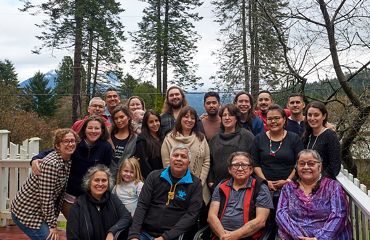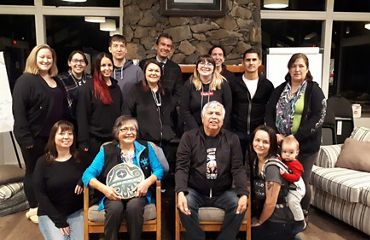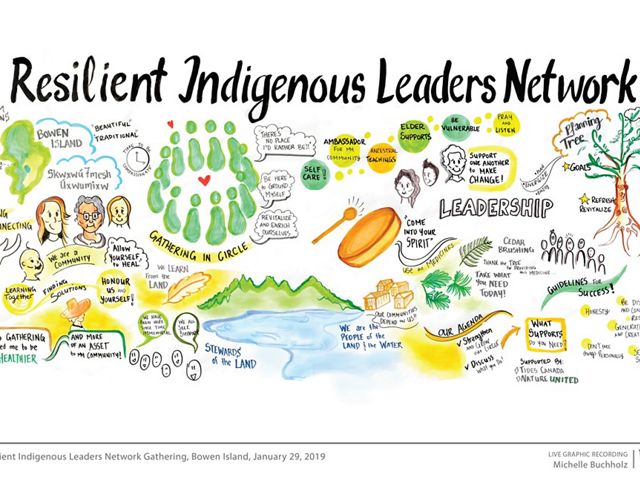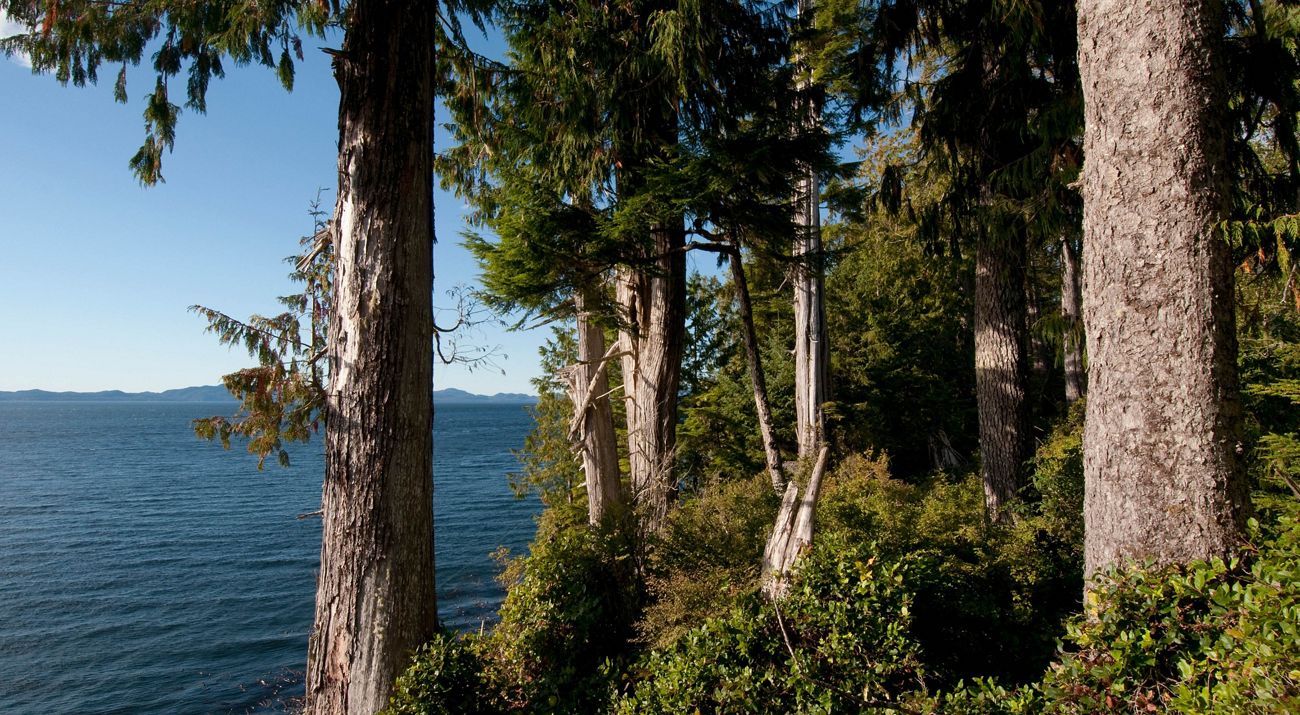Stronger Together
The Resilient Indigenous Leaders Network supports personal wellness—a critical ingredient for Indigenous sovereignty.
How do virtual coffee hours, one-on-one nutritional sessions, and sunrise yoga support Indigenous-led conservation?
In the age of Covid-19, personal wellness has taken on new significance. Especially for community leaders who are working toward Indigenous sovereignty.
Since 2018, the Resilient Indigenous Leaders Network (RILN), a peer collective founded on principles of cultural resilience and personal wellness and supported by Nature United, has provided a trove of resources for its members: professional development opportunities; peer-led learning and sharing sessions; access to personal health and wellness resources; and an annual gathering to promote peer support and aid in planning.
2020 Gathering
As the group prepares for its 2021 gathering this spring, RILN Program Director and Nuxalk Nation member Megan Moody reflected on the 2020 gathering, which took place on Bowen Island, the traditional, ancestral unceded territory of the Skwxwú7mesh (Squamish) and Səlil̓ilw̓ətaʔɬ (Tsleil-Waututh).
“The focus was on personal wellness,” she says. “We really tried to focus on helping the individual so they can strengthen themselves to be resilient in their leadership position.”
Quote: Curtis Dickie

To know that we have a place to go to for support, a safe place to discuss what challenges we face and step back from the day-to-day stress and have a look from a distance gives a chance to refocus and reset my goals.
To assist in navigating through stress, burnout and development of positive coping mechanisms, a new Indigenous counselor joined the group. An Indigenous dietician taught how to incorporate healthy eating habits and traditional foods into a busy schedule. In the months since the gathering, they’ve continued to provide webinar sessions and one-on-one counseling to support members as they navigate life in a global pandemic.
Quote: Dani Shaw
At the end of the week, I always head home feeling a bit lighter and excited for the work ahead. I think it's fundamental that personal wellness becomes more normalized and encouraged.
In addition to providing wellness resources to RILN members, the coordination team has launched a member exclusive website to provide communications and store documents. With unique relationship-building opportunities, the members have been able to identify areas of common interest. They have since created a working group focusing on Indigenous Protected Areas and an initiative to explore challenges around Indigenous Leadership.
RILN also hosts a “virtual coffee break” each week—an informal opportunity for members come together without an agenda, in a safe space. It could not have come at a better time.
“Each year I walk into the gathering feeling a little depleted, on the brink of burnout. The stimulating conversation with likeminded individuals, cultural healing ceremonies, and evening hangouts have become something I rely on to kick start my motivation. At the end of the week, I always head home feeling a bit lighter and excited for the work ahead. I think its fundamental that personal wellness becomes more normalized and encouraged.” Dani Shaw, RILN member and RILN Operational Advisor.
For Moody, the value of the gathering comes in seeing network members come together in a safe space to learn, share and be well. “This year we saw people getting together for early morning trail runs, yoga and walks, and it was really amazing that people wanted to be well together.”
2019 Gathering
One of the defining features of the second Resilient Indigenous Leaders Network gathering in January 2019 was the “Tree,” according to Megan Moody, one of the network coordinators, who comes from the Nuxalk Nation near Bella Coola, British Columbia.
The analogy helped each participant—leaders from First Nations communities throughout British Columbia—look at their leadership values (roots of the tree) and the challenges they face in trying to maintain these values; how they take care of themselves (trunk); their capacity, including who do they surround themselves with (branches); and best practices (leaves), including what they could learn from each other. The group talked about the successes they’re leading in their communities and how they can support each other (clouds).
Quote: Nuskmata

Coming to these gatherings is an opportunity to connect with others facing similar challenges, working to protect our lands and waters and strengthen our culture while dealing with the realities of colonization.
“The tree not only brought new perspective to our work, showing us how our values, challenges and capacity are connected, it also showed us how much we share as a group,” Moody says. This second gathering, held in Coast Salish territory, brought together innovative and committed leaders who fulfill important community roles and support on-the-ground stewardship in their Nations. Together, Nature United and MakeWay asked, how can we support you? “Often in our communities, it’s one person doing 10 jobs and we don’t have time to think about taking care of ourselves as people,” says Nuskmata, a participant from the Nuxalk and Secwepemc Nations. “Coming to these gatherings is an opportunity to connect with others facing similar challenges, working to protect our lands and waters and strengthen our culture while dealing with the realities of colonization. Sharing ideas and stories of resilience and staying healthy through it all—that’s empowering for me.”

Nuskmata adds, “When we come together, a lot of us are just so drained, so depleted and exhausted. Taking the time to reflect on all the good work we’ve done was really—oh wow, look what we’ve all accomplished.” Branching out from the Tree, the discussions ran the gamut, from peer support and personal wellness, to professional development and community learning exchanges. A graphic recorder created bold, colourful illustrations of the discussions over the three days. A team of Elders and cultural workers provided support to the participants through working with them one-on-one and participating in group sessions. “We tried to design the gathering differently, so it is coming from more of an Indigenous viewpoint and reflects how gathering and events happen in our communities,” Moody says. And an Indigenous facilitator—Stan Wesley from Moose Factory, Ontario, a Cree community on the south coast of James Bay—brought an Indigenous understanding and guided the participants through stories.
Nuskmata added that a few participants brought their babies. “That intergenerational element was really important—having Elders and babies at the gathering really made it feel grounded for a lot of us. It brought a different energy and feeling to the space; it’s how we work in our communities.”
Quote: Megan Moody
“We tried to design the gathering differently, so it is coming from more of an Indigenous viewpoint and reflects how gathering and events happen in our communities."
“From the first to the second gathering, we made huge gains,” says Jess Úst̓i, who is from the Heiltsuk Nation and co-coordinates the network with Moody (and is a Board Director for Nature United). “We pulled together a governance structure and strategic plan for the network that reflects our collective values and goals.” Úst̓i describes a strong sense of hope as this year’s gathering came to a close. “From a coordinator perspective, I walked away really in awe of how we just willed this into being—the network exists through mutual trust and confidence and shared energy,” Úst̓i says. “And if the network is as strong as its members, I'm 100% sure it's going to persist and thrive into the future.”
For participants like Nuskmata, the value of these gatherings is deeply felt: “The gathering and year-round support changed my life. The relationships I’ve had with other funders have been very transactional. This network focuses on taking care of the whole person. It reflects the deeper relationships that are expected in Indigenous communities, because that’s our culture.”
2018 Gathering
Across Canada, community-based Indigenous stewardship leaders play a critical role in supporting the health and well-being of their territories and their communities. They work hands on with their neighbors, with their colleagues, with officials at all levels of government; they make decisions about their lands and waters and who uses it and how; they negotiate permitting; they coordinate monitoring activities; they train staff and engage youth and conduct outreach.
“Going to work in the morning feels like walking face-first into the full blast of a fire hose most days,” says Jess Úst̓i, councilor for the Heiltsuk Tribal Council and Director of Traditional Ecological Knowledge for the Qqs Projects Society. “It feels like if you don't keep working, keep up the pressure, you'll end up being knocked back farther than where you started from.”
It’s an important question: How do these community-based Indigenous stewardship leaders take care of themselves, their communities, and their lands and waters?
An Opportunity to "Pause, Take Stock, and Regenerate"
In early 2018, a group of Indigenous community leaders from across British Columbia gathered at the Brew Creek Center, Sḵwx̱wú7mesh Territory as a first step toward a solution. The people who attended the gathering, which was hosted by MakeWay and Nature United, discussed strategies, shared success stories, made connections for future projects. But they also focused on well-being — their communities’ and also their own.
Quote: Jess Úst̓i
“This is the first time I've attended a gathering that truly felt like the intent was to build a community of support rather than to mine the expertise of myself and my peers.”
“This is the first time I've attended a gathering that truly felt like the intent was to build a community of support rather than to mine the expertise of myself and my peers,” Úst̓i says. “I think I can speak for most or all of the attendees when I say that we're people who have devoted ourselves to supporting the communities and causes we care about, and the cultural imperative driving our work makes it difficult for us to pause, take stock, and regenerate our energy.”

Building Networks
Nature United and MakeWay have long worked with Indigenous communities on their priorities related to strengthening and supporting emerging and existing leaders, with a focus on capacity building. This can mean providing resources for First Nations-led science and monitoring projects or investing in youth leadership programs that help train the next generation of conservation stewards (such as SEAS). Or it can mean supporting a strong network of community leaders.
“It helps to know you’re not the only one out there,” says Megan Moody, former Stewardship Director of the Nuxalk Nation. “I think just knowing that this group exists is helpful. I can talk things through with others and build a friendship and take that with me for years.”
Maintaining the relationships with people in this group, she says, will build resilience among the network of leaders, and help effect fundamental change in our communities.
“There are strategies we’ll bring home right away,” she says. “For example, getting out on the land with your staff and recognizing the well-being of your staff is critical to our success and being able to do good work.”

Celebrating Success
“One of the best things we did at the gathering was take time to bring forward ideas, projects, and success stories we're proud of,” Úst̓i says. “It was really affirming. I shared about our community garden in Bella Bella. It's a project close to my heart, even if it's not the biggest or most influential one on my plate.”
“Hearing the feedback from my peers about their excitement made me realize how much of an accomplishment it really is and connecting with others later in the gathering to share ideas about gardens made me realize how many milestones we've already hit.”
What Happens Next
Based on the conversations and outcomes of the gathering, Nature United and MakeWay are supporting an ongoing forum, which will be coordinated by Moody and Úst̓i, providing an opportunity for this group to stay connected and learn from each other, as well as engage other similar Indigenous stewardship leaders throughout British Columbia.
The first step will be some logistical planning, Moody points out. “We’re looking at how it will operate,” she says. “How will we share these success stories? How can we strategize toward solving bigger problems? What strategies can we bring home and implement now?”
“We know we're stronger together,” Úst̓i says. “We know that our wellbeing is important. We know that a sense of community sustains our resilience. We know that we can help each other makes leaps and bounds when we share our own best practices and lessons learned. But it's so rare, in the chaos and pressure of our day-to-day lives, that we can really make time for those things. This gathering was a strong reminder for me of why my networks matter and how they keep me strong. And I hope we can replicate the energy that emerged from our time together by gathering again and again.”
